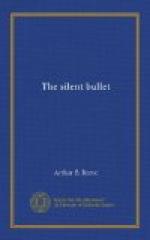Here Kennedy took up a piece of fine batiste and fired another bullet through it.
“Every leaden bullet, as I have said, which has struck such a fabric bears an impression of the threads which is recognisable even when the bullet has penetrated deeply into the body. It is only obliterated partially or entirely when the bullet has been flattened by striking a bone or other hard object. Even then, as in this case, if only a part of the bullet is flattened the remainder may still show the marks of the fabric. A heavy warp, say of cotton velvet or, as I have here, homespun, will be imprinted well on the bullet, but even a fine batiste, containing one hundred threads to the inch, will show marks. Even layers of goods such as a coat, shirt, and undershirt may each leave their marks, but that does not concern us in this case. Now I have here a piece of pongee silk, cut from a woman’s automobile-coat. I discharge the bullet through it—so. I compare the bullet now with the others and with the one probed from the neck of Mr. Parker. I find that the marks on that fatal bullet correspond precisely with those on the bullet fired through the pongee coat.”
Startling as was this revelation, Kennedy paused only an instant before the next.
“Now I have another demonstration. A certain note figures in this case. Mr. Parker was reading it, or perhaps re-reading it, at the time he was shot. I have not been able to obtain that note—at least not in a form such as I could use in discovering what were its contents. But in a certain wastebasket I found a mass of wet and pulp-like paper. It had been cut up, macerated, perhaps chewed; perhaps it had been also soaked with water. There was a washbasin with running water in this room. The ink had run, and of course was illegible. The thing was so unusual that I at once assumed that this was the remains of the note in question. Under ordinary circumstances it would be utterly valueless as a clue to anything. But to-day science is not ready to let anything pass as valueless.
“I found on microscopic examination that it was an uncommon linen bond paper, and I have taken a large number of microphotographs of the fibres in it. They are all similar. I have here also about a hundred microphotographs of the fibres in other kinds of paper, many of them bonds. These I have accumulated from time to time in my study of the subject. None of them, as you can see, shows fibres resembling this one in question, so we may conclude that it is of uncommon quality. Through an agent of the police I have secured samples of the notepaper of every one who could be concerned, as far as I could see, with this case. Here are the photographs of the fibres of these various notepapers, and among them all is just one that corresponds to the fibres in the wet mass of paper I discovered in the scrap-basket. Now lest anyone should question the accuracy of this method I might cite a case where a man had been arrested




